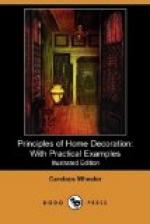The portieres separating the dining-room from the drawing-room are of a wonderfully rich green brocade—the colour of which answers to the green of the silk under-curtains across the room, while the design ranges itself indisputably with the period of the plaster work. The blue and green of the curtains and portiere each seem to claim their own in the mixed and softened background of the wall.
The colour of the room would hardly be complete without the three beautiful portraits which hang upon the walls, and suggest their part of the life and conversation of to-day so that it stands on a proper plane with the dignity of three generations. The beautiful mahogany doors and elaboration of cornice and central ornament belong to them, but the harmony and beauty of colour are of our own time and tell of the general knowledge and feeling for art which belongs to it.
I have given the colour-treatment only of this room, leaving out the effect of carved teak-wood furniture and subtleties of china and glass—not alone as an instance of colour in a sunny exposure, but as an example of fitting new styles to old, of keeping what is valuable and beautiful in itself and making it a part of the comparatively new art of decoration.
[Illustration: SCREEN BY DORA WHEELER KEITH SCREEN AND GLASS WINDOW IN HOUSE AT LAKEWOOD (Belonging to Clarence Roof, Esq.)]
There is a dining-room in one of the many delightful houses in Lakewood, N.J., which owes its unique charm to a combination of position, light, colour, and perhaps more than all, to the clever decoration of its upper walls, which is a fine and broad composition of swans and many-coloured clusters of grapes and vine-foliage placed above the softly tinted copper-coloured wall. The same design is carried in silvery and gold-coloured leaded-glass across the top of the wide west window, as shown in illustration opposite page 222, and reappears with a shield-shaped arrangement of wings in a beautiful four-leaved screen.
The notable and enjoyable colour of the room is seen from the very entrance of the house, the broad main hall making a carpeted highway to the wide opening of the room, where a sheaf of tinted sunset light seems to spread itself like a many-doubled fan against the shadows of the hall.
All the ranges and intervals, the lights, reflections, and darks possible to that most beautiful of metals—copper—seem to be gathered into the frieze and screen, and melt softly into the greens of the foliage, or tint the plumage of the swans. It is an instance of the kind of decoration which is both classic and domestic, and being warmed and vivified by beautiful colour, appeals both to the senses and the imagination.
It would be easy to multiply instances of beautiful rooms, and each one might be helpful for mere imitation, but those I have given have each one illustrated—more or less distinctly—the principle of colour as affecting or being affected by light.




